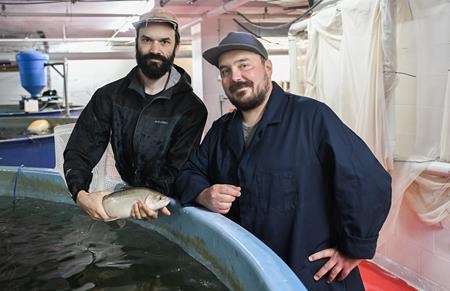Alberta
Montreal urban fish farmers say their Arctic char cuts greenhouse gases and waste

MONTREAL — A warehouse basement in an industrial area of Montreal, near the intersection of two highways, feels about as far from a fish habitat as it gets.
But walk through the doors of Opercule’s self-described “urban fish farm,” and the unmistakable smell of fish fills the air.
After donning rubber boots and lab coats, visitors are greeted with the constant hum of the plant’s filtration system. Inside the dimly lit warehouse basement, thousands of sleek, speckled Arctic char swim in a dozen or so round pools, their fins smoothly breaking the surface or sending up alarmed splashes as they scurry away from people who approach the tanks.
The business is the creation of David Dupaul-Chicoine and Nicolas Paquin, who met each other when they were studying aquaculture in college on Quebec’s Gaspé Peninsula. What began as an experiment raising fish in Dupaul-Chicoine’s garage has turned into a commercial operation that they expect will soon produce between 25 and 30 tonnes of Arctic char per year.
By raising fish on land and in an urban setting, Dupaul-Chicoine and Paquin say they hope to avoid some of the problems associated with open net fish farms, which are suspected by some conservationists of harming wild stock by spreading disease or parasites, or by escaping and interbreeding with them.
“We’re not trying to prove anything, but we’re trying to do things the way we think they should be done,” Dupaul-Chicoine said. “We’re raising fish to sell them and we’re thinking about every little step in the production. The way we deliver, the way everything is done, we try to do it in a more eco-friendly way.”
The business uses a recirculation system that filters ammonia and carbon dioxide from water, which is then reinjected with oxygen and pumped back to the tanks — vastly reducing water use. Their city setting cuts greenhouse gas emissions, as deliveries to restaurants can be done on electric bicycles. As well, they only kill fish once the animals are ordered, reducing waste. They’ve even replaced Styrofoam delivery containers with insulated cardboard, they say.
Arctic char was chosen because it sells for a good price and the animals stay healthy in close quarters.
The only downside on the environmental front, they say, is that the fish plant uses “a lot” of electricity. Their business model, Dupaul-Chicoine said, probably wouldn’t make sense if it ran on coal; luckily for them, however, Quebec has ample cheap and relatively clean hydropower.
The pair say their biggest challenge was obtaining the necessary permits — a process that took them about two years after they started their business in 2019. Because it takes 15 or 16 months for a fish to grow from an egg to market size, their first sales only came at the start of 2023.
An indoor filtration system like theirs also needs maintenance and a constant stream of electricity. Among their most stressful moments was a two-day power outage during an ice storm earlier this year; they worried that their generator would go down and cause them to lose fish.
“You have to make sure you have backups, and backups of the backups,” Dupaul-Chicoine said.
Grant Vandenberg, an aquaculture specialist at Université Laval’s agriculture and food sciences department, says land-based water-recirculation farms have some advantages over net pen farms — which are enclosed cages that float in natural water sources. Land farms eliminate concerns over environmental interactions between wild and farmed fish, and waste is easier to collect and can even be recycled into fertilizer for plants, he said.
However, land-based farms are more expensive to start and operate, and require more labour, machinery and energy than do net pens, Vandenberg said. “I think it would be very difficult for some to be able to compete economically,” he said, noting that consumers have the option to purchase imported fish produced cheaper in other countries or provinces.
Vandenberg said that despite the controversies, fish farming has an important role to play in preventing overfishing of wild stocks. Improving fish-farming technology, he added, is reducing the industry’s environmental impact.
Just as agriculture has largely replaced hunting when it comes to meat, “we have to stop hunting fish as well, and I think the answer is to produce them,” he said.
Fish farming will also improve food sovereignty, Vandenberg said, noting that Quebec — which doesn’t use open-water net pens — produces only seven per cent of the trout it consumes. He said Paquin and Dupaul-Chicoine’s operation in Montreal presents an interesting model because the plant’s proximity to its market reduces shipping costs and ensures fresher fish.
Dupaul-Chicoine and Paquin said it cost about a million dollars to launch their fish farm, which includes a processing facility, and they admit it wouldn’t have been possible without provincial government grants. However, they said they’re pleased with early sales, noting they recently passed the break-even point in terms of operational profitability.
Both said that, so far, they have no regrets. “Before this I had a career as a mechanical engineer and I decided I wanted a change,” Paquin said. “So for me, it’s fun, even though it’s hard.”
Once they’ve proved to investors and themselves that their business model can be successful, they’re hoping to expand into a bigger facility.
This report by The Canadian Press was first published Aug. 13, 2023.
Morgan Lowrie, The Canadian Press
Alberta
Alberta judge sides with LGBT activists, allows ‘gender transitions’ for kids to continue

From LifeSiteNews
‘I think the court was in error,’ Alberta Premier Danielle Smith has said. ‘There will be irreparable harm to children who get sterilized.’
LGBT activists have won an injunction that prevents the Alberta government from restricting “gender transitions” for children.
On June 27, Alberta King’s Court Justice Allison Kuntz granted a temporary injunction against legislation that prohibited minors under the age of 16 from undergoing irreversible sex-change surgeries or taking puberty blockers.
“The evidence shows that singling out health care for gender diverse youth and making it subject to government control will cause irreparable harm to gender diverse youth by reinforcing the discrimination and prejudice that they are already subjected to,” Kuntz claimed in her judgment.
Kuntz further said that the legislation poses serious Charter issues which need to be worked through in court before the legislation could be enforced. Court dates for the arguments have yet to be set.
READ: Support for traditional family values surges in Alberta
Alberta’s new legislation, which was passed in December, amends the Health Act to “prohibit regulated health professionals from performing sex reassignment surgeries on minors.”
The legislation would also ban the “use of puberty blockers and hormone therapies for the treatment of gender dysphoria or gender incongruence” to kids 15 years of age and under “except for those who have already commenced treatment and would allow for minors aged 16 and 17 to choose to commence puberty blockers and hormone therapies for gender reassignment and affirmation purposes with parental, physician and psychologist approval.”
Just days after the legislation was passed, an LGBT activist group called Egale Canada, along with many other LGBT organizations, filed an injunction to block the bill.
In her ruling, Kuntz argued that Alberta’s legislation “will signal that there is something wrong with or suspect about having a gender identity that is different than the sex you were assigned at birth.”
She further claimed that preventing minors from making life-altering decisions could inflict emotional damage.
However, the province of Alberta argued that these damages are speculative and the process of gender-transitioning children is not supported by scientific evidence.
“I think the court was in error,” Alberta Premier Danielle Smith said on her Saturday radio show. “That’s part of the reason why we’re taking it to court. The court had said there will be irreparable harm if the law goes ahead. I feel the reverse. I feel there will be irreparable harm to children who get sterilized at the age of 10 years old – and so we want those kids to have their day in court.”
READ: Canadian doctors claim ‘Charter right’ to mutilate gender-confused children in Alberta
Overwhelming evidence shows that persons who undergo so-called “gender transitioning” procedures are more likely to commit suicide than those who are not given such irreversible surgeries. In addition to catering to a false reality that one’s sex can be changed, trans surgeries and drugs have been linked to permanent physical and psychological damage, including cardiovascular diseases, loss of bone density, cancer, strokes and blood clots, and infertility.
Meanwhile, a recent study on the side effects of “sex change” surgeries discovered that 81 percent of those who have undergone them in the past five years reported experiencing pain simply from normal movements in the weeks and months that followed, among many other negative side effects.
Alberta
Alberta Independence Seekers Take First Step: Citizen Initiative Application Approved, Notice of Initiative Petition Issued

Alberta’s Chief Electoral Officer, Gordon McClure, has issued a Notice of Initiative Petition.
This confirms a Citizen Initiative application has been received and the Chief Electoral Officer has determined the requirements of section 2(3) of the Citizen Initiative Act have been met.
Approved Initiative Petition Information
The approved citizen initiative application is for a policy proposal with the following proposed question:
Do you agree that Alberta should remain in Canada?
The Notice of Initiative Petition, application, and statement provided by the proponent are available on Elections Alberta’s website on the Current Initiatives Petition page.
As the application was received and approved prior to coming into force of Bill 54: Election Statutes Amendment Act, the Citizen Initiative process will follow requirements set out in the Citizen Initiative Act as of June 30, 2025.
Next Steps
- The proponent must appoint a chief financial officer within 30 days (by July 30, 2025).
- Once the 30-day publication period is complete and a chief financial officer has been appointed, Elections Alberta will:
- issue the citizen initiative petition,
- publish a notice on the Current Initiatives Petition page of our website indicating the petition has been issued, specifying the signing period dates, and the number of signatures required for a successful petition, and
- issue the citizen initiative petition signature sheets and witness affidavits. Signatures collected on other forms will not be accepted.
More information on the process, the status of the citizen initiative petition, financing rules, third party advertising rules, and frequently asked questions may be found on the Elections Alberta website.
Elections Alberta is an independent, non-partisan office of the Legislative Assembly of Alberta responsible for administering provincial elections, by-elections, and referendums.
-

 Brownstone Institute2 days ago
Brownstone Institute2 days agoFDA Exposed: Hundreds of Drugs Approved without Proof They Work
-

 Energy1 day ago
Energy1 day agoChina undermining American energy independence, report says
-

 Business1 day ago
Business1 day agoTrump on Canada tariff deadline: ‘We can do whatever we want’
-

 Automotive1 day ago
Automotive1 day agoElectric vehicle sales are falling hard in BC, and it is time to recognize reality.
-

 Business1 day ago
Business1 day agoEurope backs off greenwashing rules — Canada should take note
-

 Automotive1 day ago
Automotive1 day agoPower Struggle: Electric vehicles and reality
-

 Business9 hours ago
Business9 hours agoCanada Caves: Carney ditches digital services tax after criticism from Trump
-

 Crime9 hours ago
Crime9 hours agoSuspected ambush leaves two firefighters dead in Idaho






